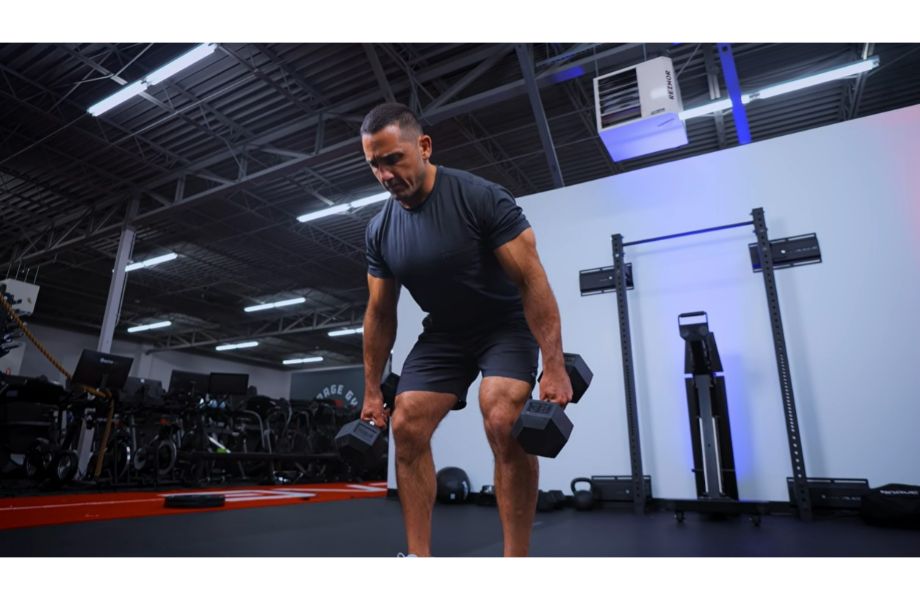We test and review fitness products based on an independent, multi-point methodology. If you use our links to purchase something, we may earn a commission. Read our disclosures.
Every workout program should include leg exercises and workouts. The legs are the foundation of the body and training them will improve your ability to get around, increase your overall athleticism, and help make you a fitter version of yourself. If you are looking for a way to train the lower body, a dumbbell-only leg workout may be just what you need.
A dumbbell leg workout allows for lots of variety in exercises and movements so you can hit every muscle group in the lower body. Whether you are looking to build muscle, build strength, or increase muscular endurance, a leg-day dumbbell workout will be able to help you achieve your desired result. These movements can be performed anywhere, either at home or the gym.
All you need is at least one pair of dumbbells. By the end of this dumbbell leg workout, you will have worked for all the main muscle groups and receive benefits that you can only get from using the dumbbells compared to other free weights.
Exercises for a Dumbbell Leg Workout
In this section, we’ll cover each exercise in depth, including what it’s good for and how, exactly, to perform it.
Goblet Squat
Squats are widely considered one of the best lower-body exercises. Squatting involves all the major muscles of the lower body while also engaging the abdominals and surrounding core, as well as the upper body (specifically the upper back and arms). In addition to building strength and muscle in the lower body, squatting can also help improve range of motion.
RELATED: Best Squat Racks
How to do it:
- Stand with your feet hip-width apart and knees pointed slightly out.
- Hold the dumbbell vertically in front of your chest with your hands cupped under the top head of the dumbbell.
- Keep your chest up and bend the hips and knees to lower down into the squat position.
- As you squat, let your knees go forward and over your toes while aiming to lower the hips just below the knees.
- Once you reach the bottom of the squat, begin to stand up by pushing your feet into the ground and bringing the hips forward into extension until you’re standing.
- If the sumo squat position is more comfortable for you, you can try that by widening your stance and pointing your feet outward.
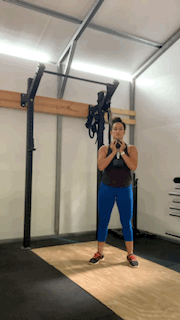
Reverse Lunge
Single-leg exercises such as lunges are important for building strength and balance in each leg individually. The reverse lunge is a great variation to build stability and strength in the front leg while minimizing stress on the knees. With the addition of dumbbells, you’ll experience more of a challenge to balance and engage the core in comparison to a bodyweight lunge.
RELATED: Best Dumbbell Exercises
How to do it:
- For this exercise, you can either utilize a goblet hold (one dumbbell in front of the chest) or a suitcase hold (a dumbbell in each hand at your sides).
- From a standing position, step backwards into the lunge so that the front foot remains flat and you come up onto the toe of the back foot.
- As you lower down into the lunge, make 90-degree angles in both knees and at the front hip.
- Your head, torso, and back knee should all be in a straight line in the bottom position.
- Once you lightly touch the back knee to the ground, return to standing by pushing through the front heel, driving the hips forward, and returning the back foot to the starting standing position.
- Keep the torso upright the entire time.
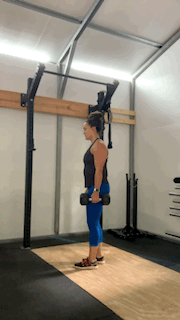
Forward Lunge
The forward lunge recruits the quads even more than the reverse lunge. This is because the quads have to stop the forward momentum as you lower into the lunge. Another benefit of this movement is that it can build up strength of the patella tendon in your knee.
How to do it:
- The main difference in the forward lunge from the reverse lunge is that you’re stepping forward into it rather than backwards.
- Step forward into the lunge, making 90-degree angles in the knees and front hip.
- Lightly tap the front knee to the ground while keeping the torso upright.
- Step backwards by pushing the ground away with the front foot.
- Return to the starting position by extending the legs.
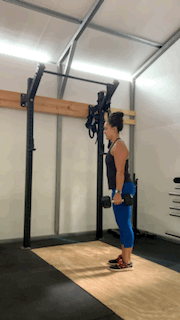
Bulgarian Split Squat
The Bulgarian split squat is one of the toughest and best leg exercises. It provides a greater stability challenge than lunges—and helps to strengthen the adductors and abductors more because of it. The motion of the split squat also helps to improve mobility by stretching the quad and hip flexor of the back leg.
How to do it:
- You will need a bench, step, or box to place your foot on for this exercise.
- Stand in front of the bench, facing away from it with a dumbbell in each hand.
- Place your left foot on the bench behind you.
- You want to be far enough away from the bench that your front knee makes a 90-degree angle at the bottom of the rep.
- Lower down by bending the front knee and hip on your planted side while keeping the chest vertical.
- As you descend, you will feel a stretch in the left quad. Try to lightly tap the back knee on the ground then come up by pressing through the front heel and extending the hip on that side. Repeat for desired reps and then switch sides.
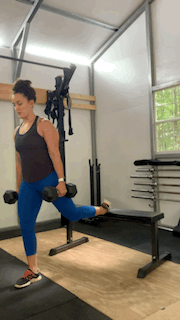
Single-Leg Deadlift
The single-leg deadlift is one of the best exercises for building balance and strength in the hamstrings and glutes. All of the muscles from the foot up into the hip go to work during this move so the body can balance on one leg while performing the exercise. This will greatly improve coordination and control of the body as a whole.
How to do it:
- For this exercise, you will want to start with just one dumbbell in one hand, but once you build confidence and strength in the movement, you may want to try with a weight in each hand.
- Start with a light dumbbell in your right hand, standing with your feet shoulder-width apart.
- Raise your left leg slightly off the ground behind you. Keep a slight bend in the right knee and lower the dumbbell down towards the ground by bending at the hip and keeping the back flat.
- As you lower the weight, the left leg will extend out behind you.
- Continue lowering until you are parallel to the ground from your head to your left heel.
- Return to the upright position by pushing through the right foot and driving the hips forward.
- Repeat for desired amount of reps, trying not to place the left foot on the ground; then repeat on the other side.
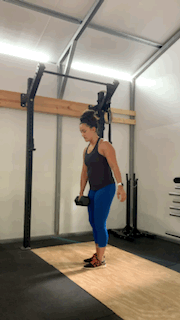
Lateral Lunge
While working out, people tend to spend a lot of time doing movements that are forward and backward or up and down, but don’t often spend as much time going side-to-side. It’s important to move in all of the directions that the body is made to move in. Lateral lunges, also called side lunges, are a great way to work the muscles that are engaged when moving side-to-side. This will help to build stronger hips, knees, and ankles.
How to do it:
- Hold the dumbbell in the goblet position.
- Step about 2 to 3 feet straight out to your side.
- Descend into the lunge by sitting your hips back on the stepping side and allowing the knee to bend forward, keeping the knee in line with the toes.
- Lower your body until the thigh is parallel with the ground, or as low as you can go without compromising the position of your spine.
- Push the ground away with the stepping foot and return to the starting position.
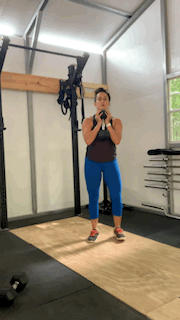
Weighted Step-Ups
Including weighted dumbbell step-ups in your lower-body routine will help even out any imbalances you may have in your right or left leg. This exercise will develop strength and power in the hips that will also transfer to other lower-body movements such as barbell squats and deadlifts. It is also a movement that can easily be scaled down by lowering the height of the platform if needed. You can easily make it harder by increasing the height or weight.
RELATED: Deadlifts Muscles Worked
How to do it:
- Use a box or step height that, when you place your foot on it, your knee is bent at a 90 degree angle. Make sure it’s on a level surface so it’s sturdy.
- Hold a dumbbell in each hand and stand no more than a foot away from the box.
- Lift one leg and place the whole foot flat on the box.
- Focus on using mainly the foot on the box to stand yourself up on it.
- Press through your heel and think about driving the hips forward and squeezing the glute of the working leg as you step up.
- Try not to lean forward too much as you step up.
- Once your leg is fully extended, place the other foot down on the box.
- Step down with the foot you stepped up with first; then, repeat with the other leg leading the step-up on the next rep.
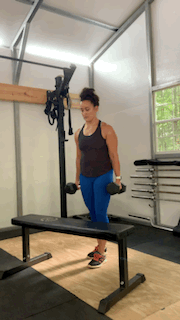
Front Squat
A dumbbell front squat will allow you to use more weight than a goblet squat because you have two dumbbells, and you may be able to get deeper in your squats due to the position of the dumbbell. Getting in a deeper squat will put tension on even more of the muscles throughout the lower body, forcing them to adapt and get stronger. This can help to improve overall mobility as the body gains better control over these positions.
RELATED: Best Adjustable Dumbbells
- Hold a dumbbell in each hand and then lift them to your shoulders so that they are horizontal.
- The head of the dumbbell closest to the shoulder should rest on the shoulder. Point your elbows out.
- Keep the elbows up and perform a squat by bending at the hips and knees.
- Descend until the hips are below the knees, or as low as you can go without rounding or hyperextending your spine.
- Allow the knees to come forward past the toes.
- Once you hit your full depth, stand up by pushing the ground away with the legs and extending the hips fully. Focus on driving through the heels.
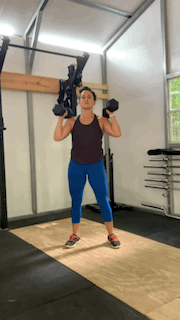
Romanian Deadlifts
The Romanian deadlift is an essential exercise when trying to build up strength and muscle in the posterior chain, which consists of all the muscles on your backside. In this exercise, mainly the glutes and hamstrings are put under a lot of tension as the body hinges at the hips in order to move the weight. A strong posterior chain is important because those muscles work to hold up and support the entire body.
- Start with a dumbbell in each hand at your sides.
- Actively pull your shoulders back and begin to lower the dumbbells down by pushing the hips back and keeping your back straight.
- As you push the hips back, the knees will begin to bend, but they will not go forward like in a squat.
- Keep hinging at the hips with your knees bent slightly until the dumbbells are just past your knees.
- Then, squeeze the glutes and push the hips forward to return to standing.
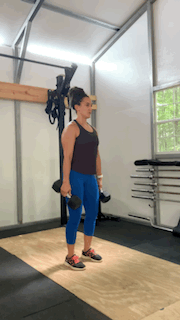
Calf Raises
Calf raises help to build stable ankles and feet. Building muscle and strength in your calves will also help to improve running ability and prevent lower body injuries and strains. Stronger calves also improve stability in all other lower body exercises by strengthening the feet and ankles.
- Hold one dumbbell in each hand with your arms at your sides.
- Push into your toes and raise your heels off the ground as high as you can while keeping the legs straight.
- Slowly lower the heels back down.
- In order to get a deeper stretch, perform these with your heels hanging off the edge of a step.

What Muscles Are You Working?
You know that when you’re doing a leg workout, you’re working your legs—duh. But what muscles, exactly, are being engaged during different leg exercises? Here’s the lowdown.
Quads
The quadriceps are a group of four muscles on the front of the thighs that work to extend the knee. Every time you stand up and extend your legs, the quads are being utilized. Strong quads are important for squatting, jumping, and maintaining healthy knees, among many other functions.
Powerful athletes typically have well developed quad muscles. Dumbbell squats, step-ups, and lunge variations are all great exercises for the quads.
Hamstrings
The hamstrings, consisting of three separate muscles, are located on the back of the thigh and have multiple functions. They work to flex the knee, extend the thigh at the hip, and rotate the lower leg when the knee is bent.
The hamstrings are there to balance out the power produced from the quads and help decelerate the body when in motion.
When these muscles are weak, they can easily be pulled when trying to run or accelerate too quickly. The Romanian deadlift and single-leg deadlift are two exercises that will build strength and muscle in the hamstrings.
Glutes
The glutes are the strong, powerful muscles on the back of the hip. Their main job is to extend the hips, but they also help with abduction and internal and external rotation of the thigh.
The glutes comprise the strongest muscle group in the body and are needed for all lower body movements that don’t isolate the knee or ankle.
Many orthopedic issues can be helped or prevented by building stronger glutes because they work with so many other parts of the body to move and stabilize various body parts. The Romanian deadlift, single-leg deadlift, goblet squats, lunges, and Bulgarian split squats will all help build up the glutes.
Abductors
The abductors move the leg away from the body and also help to rotate the leg. These smaller muscles are very important for hip stability and balance, as well as hip mobility. Having weak abductors can place more strain on the low back and knees, which can eventually cause an injury if overlooked.
Of the dumbbell leg exercises here, they are best targeted with any of the single leg movements. Make sure to focus on keeping the hips level and not letting them shift or rotate while moving.
Adductors
The adductors are the muscles of the inner thighs, and they pull the legs together. These muscles also are necessary for hip stability and mobility during lower body movements.
Similar to the abductors, the adductors can also lead to lower back or knee issues if they are neglected. The single-leg movements in thisdumbbell leg workout will also be great for the adductors, especially the lateral lunge, in which they are stretched and work to return to standing.
Benefits of a Dumbbell Leg Workout
One of the main benefits of using dumbbells over barbells is they can help with imbalances between the right and left side of the body.
A barbell is one piece of equipment and the weight is balanced between the two arms holding it, as well as through the core and lower body. Dumbbells force each side of the body to be more active in order to balance and stabilize the weight.
You also have the option to only hold a dumbbell in one hand at a time to really challenge imbalances—in this case, the body works harder in order to avoid being pulled to one side by the weight. All of these factors help to tax the body just as much, if not more, than a heavy barbell without needing as much weight.
Dumbbells also allow for more range of motion than a barbell. With a barbell, there are times when your body and the bar can get in the way of each other and prevent going any further—take the bent-over row as an example. Since dumbbells are not connected, you can move them wherever you need to in order to continue the motion.
This also helps if using a barbell puts unnecessary strain on your joints in certain positions. The dumbbells can be held, positioned, and rotated in different ways in order to find the smoothest path. An at-home dumbbell leg workout will be easier to perform than with a barbell since you only need a pair of dumbbells as opposed to a bar and set of plates and clips.
If you are looking for more intensity and volume, dumbbells can also help. With dumbbells, it is easy to switch between weights if you have a rack full of them. Just place the pair you have down and pick up the next ones. With a barbell, you have to load and unload plates.
This allows for different muscle-building techniques and the ability to to get a lot of volume stuffed into a short period of time. One technique is called a drop set, wherein you perform a set with a challenging, heavier dumbbell and then drop down to a lower weight and try to get as many reps as you can immediately after the first set.
Another technique is called “running the rack,” where you start low and work your way up until you can’t do any more reps.
Compared with kettlebells, dumbbells don’t require as much emphasis on form and technique. Of course, you should always prioritize proper lifting form, but movements tend to be easier with dumbbells than with kettlebells. This allows for more weight to be used with the dumbbells than kettlebells. It’s also safer for less experienced lifters, as a kettlebell is harder to balance and hold onto.
Dumbbell sets are also more readily accessible with most gyms having weights from 5 to 100 pounds in 5-pound increments. It is rare to find sets of kettlebells that are more than three to five different weights, and sets often don’t include lighter ones.
How Heavy Should My Dumbbells Be?
The weight of the dumbbells used will depend on each person’s strength, ability, and fitness level, as well as what movement they are performing and for what purpose.
If you are not used to using dumbbells, then it’s best to start light with an easy weight that you could do 20 comfortable reps with as you learn the form and technique. Once you feel comfortable with the movement, you can move up to weights that are more challenging.
These guidelines will help when trying to find the right weight for your desired stimulus:
- For building maximum strength, you will want to use weight that is challenging in the three to five rep range.
- If you want to focus on building muscle, then the weight should be something that is challenging between eight to 12 reps.
- More than 12 reps will primarily build muscular endurance.
- “Challenging” means that you would only be able to get one or two more reps if you were going for a max set.
Things to Watch Out For
Dumbbells are pretty safe for the most part, but there are still some precautions you may want to take in order to prevent any accidents.
One of the most important rules to follow is to avoid dropping the dumbbells on the ground. When the dumbbells are dropped, they can bounce unpredictably and could potentially land on a foot and break it.
The impact is also not good for the dumbbells and could cause them to break. Always make sure to set the dumbbells down.
The only time it is OK to drop them is if you are not able to safely set them down and holding onto the dumbbells puts you in a more dangerous position. In this case, drop them, but move away from the dumbbells before they hit the ground. Also, if you’re using weights that are that heavy, you should recruit a spotter.
When picking up the dumbbells from the rack or ground, always practice good form. Bend with the hips and knees and keep good posture in the spine. Many injuries occur not during the actual exercise, but when people are picking up or putting down dumbbells because they don’t put as much focus into this act.
Final Thoughts
A dumbbell leg workout can be just as, if not more, effective than any other type of leg workout with free weights or machines. When performed correctly, dumbbell exercises will build muscle and strength in many different ranges of motion.
- There are dumbbell exercises for every muscle group in the legs, so you can use them to increase total lower-body strength. In addition, the dumbbells provide the ability to create variations within these exercises based on how the dumbbells are held.
- Dumbbells can help to correct muscle imbalances because of all these variations that can be done with them. You are able to specifically target muscles on one side of the body to balance the right and left.
- The dumbbell’s shape allows for deeper ranges of motion in many movements than most people can achieve with a barbell. Having a whole set of dumbbells will allow for quick changes from one weight to another, which opens up the possibility for more muscle building techniques.
- They are less technical to move than a kettlebell and can be safer for those with less experience.
Dumbbell Leg Workouts FAQs
Can you build legs with dumbbells?
Dumbbells are great for building up the musculature of the legs because of the range of exercises that are available with them. The position of a dumbbell can be changed in order to target specific areas better and change up the stimulus to encourage growth. There are plenty of ways to perform a dumbbell leg workout for mass that will build the legs.
Are dumbbell leg workouts effective?
Adumbbell leg workout can be just as effective as any other resistance training modality. The main lower-body compound movements such as squats, lunges, and deadlifts—and all their variations—can all be done with dumbbells, making for a complete lower-body workout to increase leg strength.
How can I get ripped legs with dumbbells?
Getting ripped legs is a combination of building up muscle and having a low enough body fat percentage that will help show muscle definition. Performing a lower-bodydumbbell leg workout at least twice a week in combination with a healthy diet with a slight caloric deficit will help to bring out the leg definition needed to look “ripped.”
How many reps should I do with dumbbells?
The number of reps you do depends on the weight you’re using, the exercise you’re doing, and your goal (build muscle, strength, or endurance). For strength, do one to five reps; for hypertrophy, do eight to 12 reps; for endurance, do more than 12 reps.
Further reading

The Bells of Steel Trap Bar 2.0is one of many trap bars on the market, however, it is one of the only with rotating Olympic sleeves and happens to be at a pretty good price point. After using the bar over the course of three months for trap bar deadlifts, shrugs, and carries we can recommend the Bells of Steel Trap Bar 2.0 to anyone wanting a budget-priced trap bar that is superior to all at its price point (and some above.) Read more

Wondering how to use a chest press machine? A CPT explains how to do the exercise with good form, and gives modifications, variations, and alternatives to try. Read more

Are you looking to sauna in style without landing yourself in hot water? Our sauna etiquette guide gives you everything you need to know! Read more

What’s the scoop with this powerful greens supplement? In this Morning Complete review, a nutrition coach and sports dietitian tell you what you need to know. Read more

